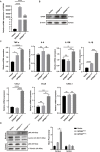Whole exome sequencing reveals novel variants associated with diminished ovarian reserve in young women
- PMID: 37065482
- PMCID: PMC10095150
- DOI: 10.3389/fgene.2023.1154067
Whole exome sequencing reveals novel variants associated with diminished ovarian reserve in young women
Abstract
Background: Diminished ovarian reserve is one of the most important causes of female infertility. In the etiology study of DOR, besides age, it is known that chromosomal abnormality, radiotherapy, chemotherapy and ovarian surgery can result in DOR. For young women without obvious risk factors, gene mutation should be considered as a possible cause. However, the specific molecular mechanism of DOR has not been fully elucidated. Methods: In order to explore the pathogenic variants related to DOR, twenty young women under 35 years old affected by DOR without definite factors damaging ovarian reserve were recruited as the research subjects, and five women with normal ovarian reserve were recruited as the control group. Whole exome sequencing was applied as the genomics research tool. Results: As a result, we obtained a set of mutated genes that may be related to DOR, where the missense variant on GPR84 was selected for further study. It is found that GPR84Y370H variant promotes the expression of proinflammatory cytokines (TNF-α, IL12B, IL-1β) and chemokines (CCL2, CCL5), as well as the activation of NF-κB signaling pathway. Conclusion: In conclusion, GPR84Y370H variant was identified though analysis for WES results of 20 DOR patients. The deleterious variant of GPR84 could be the potential molecular mechanism of non-age-related pathological DOR through its role in promoting inflammation. The findings of this study can be used as a preliminary research basis for the development of early molecular diagnosis and treatment target selection of DOR.
Keywords: female infertility; molecular etiology; ovarian reserve; point mutation; whole exome sequencing.
Copyright © 2023 Li, Xu, Liu, Zhou, Zou, Wang, Li, Yang, Piao and Zhang.
Conflict of interest statement
The authors declare that the research was conducted in the absence of any commercial or financial relationships that could be construed as a potential conflict of interest.
Figures





Similar articles
-
Forecasting early onset diminished ovarian reserve for young reproductive age women.J Assist Reprod Genet. 2021 Jul;38(7):1853-1860. doi: 10.1007/s10815-021-02155-8. Epub 2021 Mar 30. J Assist Reprod Genet. 2021. PMID: 33786734 Free PMC article.
-
Novel variants in women with premature ovarian function decline identified via whole-exome sequencing.J Assist Reprod Genet. 2020 Oct;37(10):2487-2502. doi: 10.1007/s10815-020-01919-y. Epub 2020 Aug 13. J Assist Reprod Genet. 2020. PMID: 32789750 Free PMC article.
-
New insights into the genetic basis of premature ovarian insufficiency: Novel causative variants and candidate genes revealed by genomic sequencing.Maturitas. 2020 Nov;141:9-19. doi: 10.1016/j.maturitas.2020.06.004. Epub 2020 Jun 20. Maturitas. 2020. PMID: 33036707
-
Reproductive ovarian testing and the alphabet soup of diagnoses: DOR, POI, POF, POR, and FOR.J Assist Reprod Genet. 2018 Jan;35(1):17-23. doi: 10.1007/s10815-017-1058-4. Epub 2017 Oct 2. J Assist Reprod Genet. 2018. PMID: 28971280 Free PMC article. Review.
-
Diminished ovarian reserve in recurrent pregnancy loss: a systematic review and meta-analysis.Fertil Steril. 2020 Apr;113(4):818-827.e3. doi: 10.1016/j.fertnstert.2019.11.014. Epub 2020 Mar 4. Fertil Steril. 2020. PMID: 32145928
Cited by
-
Transcriptomic signatures of WNT-driven pathways and granulosa cell-oocyte interactions during primordial follicle activation.PLoS One. 2024 Oct 23;19(10):e0311978. doi: 10.1371/journal.pone.0311978. eCollection 2024. PLoS One. 2024. PMID: 39441825 Free PMC article.
-
The Impact of FSHR Polymorphisms (rs6165 and rs6166) on Ovarian Response to Stimulation in Infertile Women with Diminished Ovarian Reserve.Appl Clin Genet. 2025 Jul 12;18:119-129. doi: 10.2147/TACG.S528567. eCollection 2025. Appl Clin Genet. 2025. PMID: 40673166 Free PMC article.
-
Analysis of single-cell RNA sequencing in human oocytes with diminished ovarian reserve uncovers mitochondrial dysregulation and translation deficiency.Reprod Biol Endocrinol. 2024 Nov 15;22(1):146. doi: 10.1186/s12958-024-01321-8. Reprod Biol Endocrinol. 2024. PMID: 39548561 Free PMC article.
-
Diminished ovarian reserve is associated to euploidy rate: a single center study.Front Endocrinol (Lausanne). 2025 Jan 17;15:1535776. doi: 10.3389/fendo.2024.1535776. eCollection 2024. Front Endocrinol (Lausanne). 2025. PMID: 39897960 Free PMC article.
-
Proximity extension assay revealed novel inflammatory biomarkers for follicular development and ovarian function: a prospective controlled study combining serum and follicular fluid.Front Endocrinol (Lausanne). 2025 Feb 10;16:1525392. doi: 10.3389/fendo.2025.1525392. eCollection 2025. Front Endocrinol (Lausanne). 2025. PMID: 39996063 Free PMC article.
References
LinkOut - more resources
Full Text Sources
Research Materials

